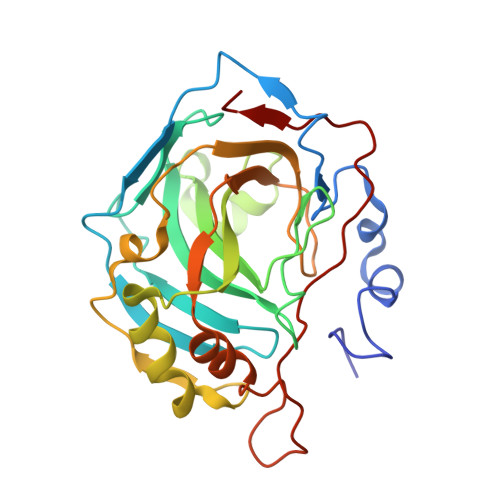Structural and Kinetic Characterization of Active-Site Histidine as a Proton Shuttle in Catalysis by Human Carbonic Anhydrase II
Fisher, Z., Hernandez Prada, J.A., Tu, C.K., Duda, D., Yoshioka, C., An, H., Govindasamy, L., Silverman, D.N., McKenna, R.(2005) Biochemistry 44: 1097-1105
- PubMed: 15667203
- DOI: https://doi.org/10.1021/bi0480279
- Primary Citation of Related Structures:
1T9N, 1TB0, 1TBT, 1TE3, 1TEQ, 1TEU, 1TG3, 1TG9, 1TH9, 1THK - PubMed Abstract:
In the catalysis of the hydration of carbon dioxide and dehydration of bicarbonate by human carbonic anhydrase II (HCA II), a histidine residue (His64) shuttles protons between the zinc-bound solvent molecule and the bulk solution. To evaluate the effect of the position of the shuttle histidine and pH on proton shuttling, we have examined the catalysis and crystal structures of wild-type HCA II and two double mutants: H64A/N62H and H64A/N67H HCA II. His62 and His67 both have their side chains extending into the active-site cavity with distances from the zinc approximately equivalent to that of His64. Crystal structures were determined at pH 5.1-10.0, and the catalysis of the exchange of (18)O between CO(2) and water was assessed by mass spectrometry. Efficient proton shuttle exceeding a rate of 10(5) s(-)(1) was observed for histidine at positions 64 and 67; in contrast, relatively inefficient proton transfer at a rate near 10(3) s(-)(1) was observed for His62. The observation, in the crystal structures, of a completed hydrogen-bonded water chain between the histidine shuttle residue and the zinc-bound solvent does not appear to be required for efficient proton transfer. The data suggest that the number of intervening water molecules between the donor and acceptor supporting efficient proton transfer in HCA II is important, and furthermore suggest that a water bridge consisting of two intervening water molecules is consistent with efficient proton transfer.
- Department of Biochemistry and Molecular Biology, College of Medicine, University of Florida, Gainesville, Florida 32610, USA.
Organizational Affiliation:


















